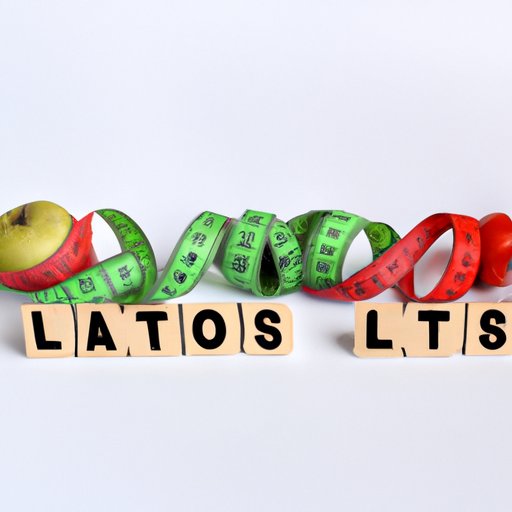
I. Introduction
The equation for successful weight loss is really quite simple: consume fewer calories than your body burns on a daily basis. However, determining the optimal number of calories to eat for weight loss can be a bit more complicated. If you’re looking to lose weight, determining the right number of calories to consume is key to your journey. In this article, we’ll explore the basics of caloric intake for healthy weight loss, provide tips for reducing caloric intake, explain different weight-loss strategies and approaches, and provide important information on tracking your calories, making healthy food choices, and incorporating lifestyle changes.
II. The Basics of Caloric Intake for Healthy Weight Loss
Before delving into different weight-loss strategies and approaches, it’s essential to understand the basics of caloric intake for healthy weight loss.
Several factors affect an individual’s caloric needs, including age, gender, weight, and activity level. The average adult needs to consume about 2,000 calories per day to maintain their current weight. A safe and healthy rate of weight loss is between 1-2 pounds per week, which can typically be achieved by cutting 500-1000 calories from your daily intake.
Tips for reducing caloric intake in a healthy way include: replacing processed foods with fresh fruits and vegetables, opting for lean proteins, reducing portion sizes, and avoiding high-sugar drinks in favor of water or unsweetened tea or coffee.
III. Caloric Intake for Different Weight-Loss Strategies
There are many different weight-loss strategies and approaches, each with varying effects on caloric intake. It’s essential to understand the recommended daily calorie intake for each strategy to reach your goals safely and successfully.
For example, a low-carbohydrate diet like keto typically involves consuming 20-50 grams of carbs per day and increasing healthy fat intake to 70-80% of daily calories. Alternatively, a low-fat diet may only contain 15-20% of daily calories from fat, with an emphasis on complex carbohydrates and lean proteins.
It’s crucial to remember that there are potential benefits and drawbacks to each strategy, and finding the right approach for you is essential. Sticking to a customized meal plan and tracking your calories can also help you achieve success with each strategy.
IV. Tracking Your Calories: Why It’s Important and How to Do It
Tracking caloric intake daily can help you reach your weight-loss goals faster and more safely. It allows you to better understand how many calories you are consuming and can help you make better food choices and portion control.
Some effective tracking methods include using mobile apps or trackers, keeping a daily food journal, or using kitchen scales to measure portions accurately.
Preparing healthy meals with a specific calorie count in mind can also help you stay on track and avoid overeating. Cooking at home more often and choosing fresh, whole foods can make a significant difference when it comes to long-term weight loss goals.
V. How Many Calories Should You Eat to Lose X Pounds Per Week?
Determining the correct caloric intake to achieve specific weight-loss goals can be tricky, but it’s essential to achieve long-term success. The recommended rate of weight loss is 1-2 pounds per week, which typically translates to a daily caloric deficit of 500-1,000 calories.
You can calculate your personalized approach to caloric intake by using an online calculator or consulting a healthcare professional, keeping factors such as lifestyle, food preferences, and activity levels in mind.
You may need to adjust your caloric intake as your weight changes to continue seeing results, and it’s best to consult with a professional to ensure you’re on the right path.
VI. Caloric Intake for Different Lifestyle Factors
Stress, sleep patterns, and physical activity levels all affect your body’s caloric needs, and it’s important to adjust your intake with these factors in mind. For example, if you increase your level of activity, you’ll need to adjust your food intake accordingly.
And, incorporating physical activity into your daily routine is essential for weight loss, but it’s important to start slow and gradually increase activity levels for optimum success.
Maintaining a healthy and balanced lifestyle while losing weight is also key to long-term success. Some tips for achieving this include getting sufficient sleep, managing stress levels, and focusing on nutrient-dense foods.
VII. How to Maintain a Safe and Sustainable Caloric Deficit for Weight Loss
It’s essential to avoid overly-restrictive diets in favor of a healthy and sustainable caloric deficit. Rapid weight loss or extreme caloric deficits can put a strain on your body, leading to health issues.
The key to maintaining a safe and sustainable caloric deficit is to avoid crash or fad diets in favor of creating a balanced and nutritious meal plan that incorporates weight loss goals. It’s also important to incorporate regular exercise into your routine and focus on nutrient-rich foods instead of low-calorie or highly processed options.
VIII. The Importance of Consulting a Healthcare Professional for Weight-Loss Advice
Having access to personalized advice from a healthcare professional is essential for achieving long-term weight loss success, particularly if you have pre-existing health conditions or are at risk of health complications.
These professionals can provide information on customized meal plans, offer lifestyle and exercise recommendations, and provide guidance on maintaining a healthy caloric intake. It’s important to seek out qualified nutritionists or dietitians to ensure you’re getting the best advice for your body’s needs.
IX. Conclusion
When it comes to weight loss, determining optimal caloric intake requires a bit of planning and focus. Understanding the factors that impact your caloric needs and tailoring your approach to meet your personal goals and preferences is key. Incorporating healthy food choices, staying physically active, avoiding overly-restrictive diets, and seeking personalized advice from qualified professionals can help you achieve long-term weight loss success.





